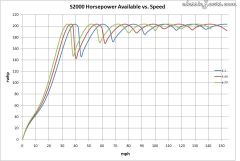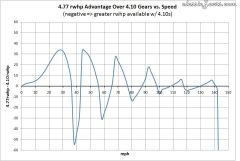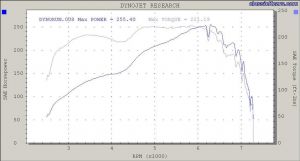Everything posted by Dan Baldwin
- s2k_rwhp_mph
- sk2_477hp_410hp
-
Panasport Wheel Weight
I've personally seen cracked spokes on "racing only" Pana's. The geometry is the same, the material is the same, and there's less of it, no way around it, they're running at higher stresses. I'm not saying they are not a "high quality" cast wheel. But there absolutely is a REASON the lighter weight wheels are specified for racing use only. They have less fatigue life in them. Street usage over 10's of thousands of miles is harder on wheels than multiple race seasons. The stresses of repeated 1-g braking and cornering for ~ an hour's usage per event are minimal compared to going over cobblestones, potholes, etc. etc. for 10,000 miles per year. Again, talking about fatigue life, not impact damage. If you don't put very many miles on your car, no big deal, but in any case, the lighter weight wheels will not last as long as the heavier ones.
-
Panasport Wheel Weight
The lightweight racing Panasports are prone to developing cracks in the spokes when used extensively on the street. At least they were 10 or so years ago... I don't think the "racing" ones are forged, and they look similar to the heavier "street" ones. To be significantly lighter, they sacrifice longevity. There is a reason they're marked "for racing use only"!
-
R200 LSD break away torque
Mine (fresh from a junkyard '87 turbo) measured 23 lb-ft YEARS ago. Gotta be less than that now. No problemo on the track, even with 238-255rwhp driving it. Dunno why anyone would run as much as 80-90. Basically, that would FORCE you to use a bigger rear sway bar, which acts to increase the amount the inside wheel is unloaded, sort of a vicious cycle I think. I'm running no rear bar, btw. I don't think I'd go with more than the 45 lb-ft the Nismo units supposedly came with.
-
Front Brake Upgrades
Yup. But consider that your car's braking system, ancient as it is, was designed and engineered by professionals to ensure proper braking distribution. You will either need to educate yourself on this to determine what is required, or find an engineered and tested setup (and I'm sure there are setups out there that have NOT been engineered OR tested). Don't just throw a "big" brake setup at the back to balance the "big" brakes up front and hope for the best. You need to ensure that the rotor working diameters and caliper piston areas conspire to give proper front/rear balance, while ensuring the fronts lock before the rears.
-
Front Brake Upgrades
That *IS* scary. Something's wrong with your brakes for sure, no way the rears should lock first. I'd have a look in there, could be the rears are dragging. Or you have teflon brake pads up front :eek:
-
Front Brake Upgrades
Theoretically, it's only normal (clamping) force times coefficient of friction that dictates frictional force, irrespective of area of contact. The 4x4 pads have 4% greater area => with the same coefficient of friction, they give 4% more braking force than the original calipers. Again, it's a good thing they don't give MORE, because there's already too much front bias! True. Also, less heel/toe action, better wear characteristics, should give better modulation, should run cooler, etc. But to me it isn't worth it to JUST do the front 4x4 caliper mod, as it increases front bias, and stock is already conservatively biased to the front. More front bias => rears are doing less braking at front lockup => less total braking force at front lockup => longer stopping distances.
-
Racing Tire Recommendations, Please
I ran Hoosier R3S04's (the new ones) at two time trial events last year. First event I ran them at, for the first few laps holy CRAP i've never experienced so much grip! Then after about 3-4 laps they kinda lost some. After three sessions ~15 minutes each, this effect was reduced a bit. Second event I went to, they felt really slippy-slidey, but I turned my best ever time with them. They WENT faster than they FELT. The character was quite different from the old Hoosiers, the car moved around a lot more rather than carving the curves. Still fast though!
-
Front Brake Upgrades
FWIW, there is still 30% of the car's weight on the rear tires at 1-g braking, unlike a motorcycle which has a MUCH shorter wheelbase and higher center of gravity. Stock setup biases the fronts. Further biasing towards the front should actually INcrease ultimate stopping distances, as the rears will be doing even less at impending front lockup. Fortunately, the Toyota truck calipers only have 4% more piston area than stock. Still, I don't really consider this mod (front 4-pot truck calipers ONLY) an "upgrade".
-
L24 L26 L28 Dyno results
Tom, At what rpm were you making peak power? Mine peaks at ~6250-6500. I limit it to 7000, sometimes 7200. Anyway, if your peak torque in lb.-ft is less than your peak power in hp, there's definitely more hp to be had given a big cam, big carbs, and headwork, whatever the absolute NUMBERS are. My peak hp is ~15-18% greater than my torque in lb-ft.
-
L24 L26 L28 Dyno results
My car has dynoed at 255rwhp (see my post on page 1 for link), but only once. Two other dyno runs on different occasions (both before and after the 255 run) had me at 235 and 238 respectively. On the same day I did 238rwhp, stock 350Z's (factory rated at 287 at the flywheel) were doing 240rwhp (DANG!). Stuff to consider, anyway...
-
June 03 Dyno Run
Late reply, I don't cruise by all that often.. The DAY before the dyno, my 280Z distributor's module died. Had to install the points distributor. Even with brand new points, bounce killed it above 6200. Cam is a custom Sunbelt grind. ~.550" lift, ~310 duration. She doesn't idle well (poor carb tuning doesn't help).
-
L24 L26 L28 Dyno results
Dyno sheet here: http://www.classiczcars.com/photopost/showphoto.php?photo=6881&size=big&sort=1&cat=500 For some reason I couldn't get the image location... Anywho, 255 rwhp (on that day, anyway...) NA 3.1 liter (KA24+.5mm pistons, LD28 crank) Sunbelt ported and cammed N42 head 11:1 CR 45mm OER racing 3x2 carbs, 39mm venturis Nismo 1 3/4" 6=>2 header, 3" exhaust That's about it...
-
Flywheel Sizes
Generally, coupes have 225mm flywheels, 2+2s have 240mm. Different clutches, too.
-
Tripple Webbers
200hp? I wouldn't bother with the L24, get a flat-top piston L28 ('81?+ non-turbo), put an N42 or N47 head on it from a dished-piston motor (or shaved P79 or P90), mild cam, and you're about there.
-
Tripple Webbers
Stage 2 meaning ~260/.460"? Stock carbs should work fine, actually, on a 2.4 liter anyway. Word is the dual downdraft Webers are nothing special, no better than the stock carbs. Triple deuces, now you're talkin! Much better at making high-rpm power.
-
Coolest cars of all time...
Gawd you guys go for PIGS of cars! Sign me up for a neon yellow-green Lotus Elise! OK, I do confess to a weakness for circa '70 Mopars. Can't afford a Hemi Cuda or Challenger, or AAR Cuda or Challenger T/A, but maybe one day I'll build a hot pink or lime green Duster or Demon 340 for roadracing. Yeah, that'd be sooo coooool...
-
HybridZ.org left me confused :S
If your goal is semi-modest (say ~350-400rwhp) I'd go SBC, and wouldn't worry about the "old tech" vs. "new tech". The RB is a big heavy motor, carries its weight high, and can't be set back NEARLY as far as the small block V8 can. I'd bet you can make a lighter-weight car with a lower more rearward c.g. going the V8 route vs. RB. Also, for hillclimb, I'd rather go NA than turbo. Immediate throttle response, zero lag.
-
Just picked up 73 240z. Should I rebuild the L24 or swap to something else???
Maybe the "leaner is meaner" misconception comes from the turbo world, where they run a lot richer as a hedge against detonation. If you're in the 11 - 12:1 A/F range, then leaner will make you more power, but with a medium - high-boost turbo application you're sorta taking a risk. NA, not a problem.
-
Just picked up 73 240z. Should I rebuild the L24 or swap to something else???
Whoa, lean mixture gives MORE power? This misconception must be going around, I read on the SV650 site that "leaner is meaner" (i.e., more power). This is absolutely untrue, max power is made on the RICH side of stoichiometric. Stoich is ~14:1 (14.7:1?). Max power is *typically* made around 13:1, and power falls off quicker on the lean side. 12.5:1 - 13:1 is a pretty good target. It is common practice to dyno tune for maximum power if no sniffer is available, as tuning for maximum power will put you in a safe A/F region.
-
Just picked up 73 240z. Should I rebuild the L24 or swap to something else???
I bought my bolt-in 4-point roll bar from Kirk Racing in (Birmingham?) Alabama. Only ~$250 IIRC. I needed it for time trials competition, I confess I just bolted it in with some improvised spacers and backing plates, not exactly a professional job:) But their bar does pretty much fit, and the main hoop bolts to the floor, not the deck. Rear feet bolt to the wheel housings in front of the strut towers.
-
Just picked up 73 240z. Should I rebuild the L24 or swap to something else???
238 at the wheels. I agree, I like 255 better! Hopefully the 255 is the dyno reading ~3.5% high and the 238 is the dyno reading ~3.5% low, I wouldn't like to think I actually lost that much over the course of a year. FWIW, the plots are pretty much off by the same amount everywhere, down ~7% throughout the rev range. I'm running 11:1 CR on 93 pump. I wanted to aim for 11.25:1, but it wasn't in the cards even with customized gasket thickness (piston/valve clearance issues). I don't think you could do much more than that with a big-cammed (mine's ~310/.550") L6 on pump gas. *Maybe* 11.5:1, but I wouldn't risk it. 1.8 liter Hondas have much smaller bores, allowing higher compression ratios. 600cc 4-cyl motorcycles are running 13:1 stock now! 205-215 to the WHEELS, out of 1.8 liters, on PUMP GAS?! What was that, at like 8800 rpm? Me wanna make a mid-engine CRX with one o' those engines! I don't know of anyone making more than myself on pump gas, but I'm sure they're out there. John Coffey is making 287 at the wheels with a 3.0 liter with 13.4:1 CR on race gas. No-expenses spared Sunbelt-developed and -built motor, through a $$$$ straight-cut-gears race gearbox and Quaife rear end. That's probably about as much as the most serious GT-2 L6s make/made.
-
Just picked up 73 240z. Should I rebuild the L24 or swap to something else???
No pics of the engine compartment (it's ugly, anyway). Basically it's an 11:1 CR 3.1 with Sunbelt ported and cammed (~310deg/.550") N42 head, 3x2 45mm carbs. Two years ago it dynoed at 235rwhp. Last year after a rebuild, it made 255rwhp(!), but earlier this year it only did 238. I've been robbed! From the TEP website, you thinking about the carbs or the rebuild kit? Depending on what you want to do, you might not need forged pistons. FWIW, I'm using Nissan KA24 cast pistons in my motor. Unless you're going 13:1 CR, or turbo, or over 7500rpm, I don't think forged pistons are needed. Regarding carbs, you can get used ones cheaper, but then they are of course, USED. I got mine for $600 used, then spent ~$280 on an ITG air filter and backing plate, yow! Used or new, carbs will get you way more hp/$ than the super-duper 6-butterfly FI setup.
-
Just picked up 73 240z. Should I rebuild the L24 or swap to something else???
Dome-top (as opposed to '73/'74 flat-top) SU carbs will be absolutely fine for the street. Can't see spending the $$$$ for the six-butterfly FI setup, but if money's no object...






